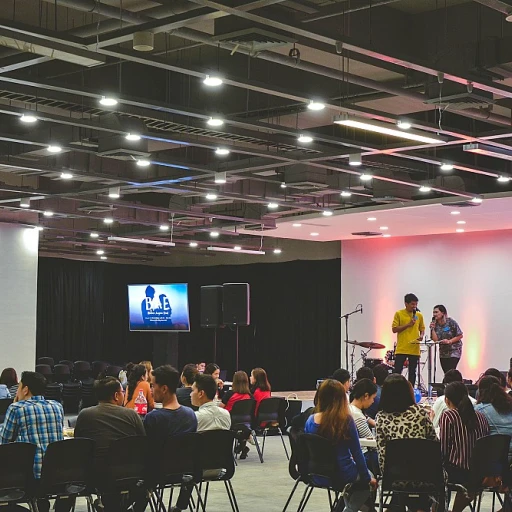
Understanding Continuous Improvement in Tech Hiring
The Essence of Continuous Improvement in Recruiting for Tech
Continuous improvement is a cornerstone philosophy not just in manufacturing, but increasingly in tech hiring. Embracing this method means regularly assessing and refining hiring processes to enhance efficiency, quality, and outcomes. It's a strategic approach that draws from established methodologies like Lean and Sigma, focusing on streamlining and refining recruitment strategies. In tech hiring, this entails implementing structured measures through courses and training programs aimed at better identifying and attracting top talent. An improvement manager might engage in process mapping to identify inefficiencies, while a focus on change management ensures adaptations are effectively rolled out. Investing in online courses on project management or earning certificates such as the Green Belt in Lean Sigma can prepare hiring professionals to lead recruitment with precision. A comprehensive view course on continuous improvement in tech hiring enhances a manager's capabilities, equipping them to tackle skill shortages effectively. Improvement training programs emphasize the importance of quality management, thus ensuring the recruitment process is both rigorous and adaptable to the dynamic tech landscape. For businesses keen to explore potential avenues in continuous improvement, exploring career opportunities in PT solutions might offer valuable insights. This continuous process underscores the need for a flexible and responsive approach to remain competitive in tech hiring.Identifying Skill Gaps and Training Needs
Pinpointing Opportunities for Development through Skill Gaps
Navigating the intricate landscape of tech hiring demands a keen focus on identifying skill gaps and aligning training needs. This process is pivotal to ensuring that both businesses and professionals are equipped to thrive in an ever-evolving industry. Pinpointing skill gaps requires a meticulous analysis of current capabilities versus the desired skill set. This gap analysis is a cornerstone of effective continuous improvement, shedding light on the precise areas where enhancement is needed. Organizations often employ tools such as process mapping and quality management assessments to gain insights into workforce competencies. Here's how to effectively identify and address these gaps:- Conduct Comprehensive Skill Audits: Regular audits, involving both self-assessments and manager evaluations, help in outlining the existing abilities and highlight areas for development.
- Leverage Lean and Sigma Methodologies: Utilizing Lean Sigma techniques can streamline processes and eliminate waste, allowing tech teams to focus on impactful training initiatives like green belt and black belt courses.
- Engage with Continuous Improvement Training: Online courses and certification programs provide flexible and targeted training opportunities, helping professionals across roles, from project managers to improvement managers, build the necessary competencies.
- Foster a Culture of Continuous Learning: Establishing a business culture that promotes ongoing education and skill enhancement is fundamental. Management support for these initiatives reinforces a commitment to excellence.
Implementing Continuous Improvement Strategies
Deploying Effective Continuous Improvement Strategies
Implementing continuous improvement strategies in tech hiring necessitates an understanding of various methodologies such as Lean, Six Sigma, and Agile. By adopting these methodologies, organizations can refine their recruitment processes, focusing on quality management and efficiency. The integration of continuous improvement training programs, be it online courses or in-person workshops, can equip hiring managers with essential skills like process mapping and business process optimization.
An effective improvement process involves an analysis of the current recruitment methods and the identification of key areas that need enhancement. By launching lean sigma initiatives or enrolling professionals in specialized programs like the Sigma Green Belt or the Black Belt certification, organizations can foster systematic changes that contribute to sustainable growth.
As a cornerstone of change management, continuous process improvement thrives when there is a commitment to ongoing training and certification. Improvement managers play a crucial role by steering these projects, ensuring that the methodologies remain aligned with the organization's strategic goals. The incorporation of project management principles further amplifies the efficiency of these strategies.
For businesses seeking to implement these strategies, it's essential to view course offerings that align with desired outcomes. Detailed process mapping coupled with regular quality management assessments will ensure that improvements yield tangible results. By employing robust continuous improvement strategies, companies can nurture a culture of perpetual enhancement, vital for maintaining a competitive edge in tech hiring.
To deepen your understanding of how strategic measures like "no-poaching agreements" can influence tech hiring dynamics, read more here.
Measuring the Impact of Continuous Improvement
Evaluating the Benefits of Improvement Strategies
Measuring the impact of continuous improvement in tech hiring requires a thorough analysis of various elements. After implementing strategies such as lean manufacturing and process mapping, assessing their effectiveness is crucial to ensure they enhance the quality of skills such as project management and change management.
The first step is to define clear metrics and benchmarks. These will act as a guide for evaluating the success of improvement training, including green belt and black belt certifications. By tracking these metrics, organizations can establish a baseline for measuring progress.
Feedback mechanisms are also essential in the process. Surveys and interviews with team members can provide insights into how training courses, both online and in-person, improve knowledge and skills. Continuous feedback loops allow for ongoing adjustments to strategy and course content, thus managing and aligning with business goals.
Moreover, management should not overlook the benefits of lean sigma and sigma green methodologies. These tools promote a culture of efficiency and waste reduction, integral to the success of any continuous process improvement program. By integrating these methodologies into training programs, organizations can yield significant advancements in quality management and effectiveness.
Course evaluations should also focus on the role of the improvement manager. Their ability to guide the team through lean processes and business process transformations can significantly influence the outcomes. Regular check-ins and performance assessments help maintain momentum and drive towards achieving business objectives.
Challenges and Solutions in Continuous Improvement Training
Overcoming Hurdles in Skills Enhancement
Continuous improvement in tech hiring isn't without its challenges, particularly when it comes to training programs and courses. The complexity of aligning business objectives with training needs often poses a significant obstacle. Companies need a robust management process to effectively bridge this gap. This involves tailoring lean and sigma training programs to address specific skill gaps and maximize improvement. One effective strategy is the utilization of lean sigma approaches. Lean manufacturing principles can streamline processes, reduce waste, and improve the overall quality of training programs. An improvement manager or course coordinator can implement lean processes, which help in achieving certifications such as a green belt or black belt in process improvement. Yet, another challenge is maintaining the motivation and engagement of employees in ongoing training. Continuous improvement demands commitment, which can be bolstered through the integration of online and in-person courses. Utilizing project management and change management techniques can ensure consistent progress and adaptability in learning environments. Access to high-quality courses and trainers is also a frequent hurdle. Companies need to ensure their staff can participate in recognized management courses and obtain certifications that add value. This could involve forming partnerships with reputable providers, offering courses ranging from project management to quality management. Implementing continuous improvement strategies effectively requires a sound understanding of the existing business process, thorough process mapping, and consistent process analysis to adjust to changing needs. A strategic approach to overcoming these challenges can lead to significant improvements in tech hiring outcomes.Future Trends in Continuous Improvement for Tech Hiring
Emerging Trends in Continuous Improvement for Tech Hiring
The landscape of tech hiring is constantly evolving, and continuous improvement is at the forefront of this transformation. As businesses strive to remain competitive, they are increasingly turning to innovative strategies to enhance their hiring processes. Here are some key trends that are shaping the future of continuous improvement in tech hiring:
- Integration of AI and Machine Learning: AI and machine learning are revolutionizing the way companies identify skill gaps and training needs. These technologies enable more precise analysis of candidate skills and help in tailoring improvement training programs to meet specific requirements.
- Emphasis on Lean and Six Sigma Methodologies: Lean manufacturing and Six Sigma principles are being adapted to the hiring process to streamline operations and improve quality management. This approach helps in reducing waste and enhancing efficiency in talent acquisition.
- Online and Remote Training Programs: With the rise of remote work, online courses and training programs have become essential. These programs offer flexibility and accessibility, allowing employees to engage in continuous improvement training from anywhere in the world.
- Focus on Change Management: As organizations implement new technologies and processes, change management becomes crucial. Effective change management strategies ensure that teams are prepared to adapt to new systems and methodologies, fostering a culture of continuous improvement.
- Certification and Skill Validation: Certifications such as Lean Sigma Green Belt and Black Belt are gaining popularity as they validate an individual's expertise in process improvement. These certifications are becoming a standard requirement for improvement managers and project managers in the tech industry.
As these trends continue to develop, companies that embrace continuous improvement will be better positioned to attract and retain top talent. By focusing on quality management and process improvement, businesses can create a more efficient and effective hiring process, ultimately leading to greater success in the tech industry.












